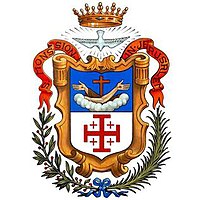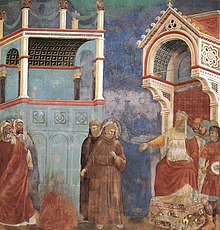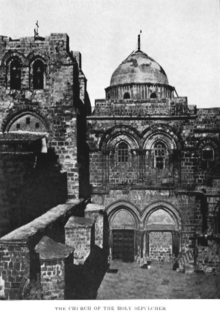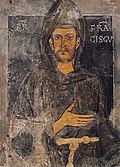Custody of the Holy Land
Latin: Custodia Terræ Sanctæ | |
 Coat of arms of the Custody of the Holy Land | |
| Formation | 1217 |
|---|---|
| Founder | Saint Francis of Assisi |
| Founded at | Porziuncola, Assisi, Umbria |
| Purpose | "The grace of the Holy Places" |
| Headquarters | Monastery of Saint Saviour |
| Location | |
Region | Holy Land; Middle East |
| Services | Fathers of the Holy Sepulchre |
| Father Francesco Patton | |
| Father Dobromir Jasztal | |
General Secretary | Father Marco Carrara |
Parent organization | Order of Friars Minor |
| Affiliations | Latin Patriarchate of Jerusalem Order of the Holy Sepulchre |
| Website | www |
The Custody of the Holy Land (Latin: Custodia Terræ Sanctæ) is a custodian priory of the Order of Friars Minor in Jerusalem, founded as Province of the Holy Land in 1217 by Saint Francis of Assisi, who also founded the Franciscan Order. Its mission is to guard "the grace of the Holy Places" of the Holy Land and the rest of the Middle East, "sanctified by the presence of Jesus",[1] as well as pilgrims visiting them, on behalf of the Catholic Church.[2][3] In 1342, the Franciscans were declared by two papal bulls as the official custodians of the Holy Places in the name of the Catholic Church.[4]
The Custody headquarters are located in the Monastery of Saint Saviour, a 16th-century Franciscan monastery near the New Gate in the Old City of Jerusalem. The office can bestow—only to those entering its office—the Jerusalem Pilgrim's Cross upon deserving Catholic visitors to the city.[citation needed]
The Franciscans trace their presence in the Holy Land to 1217. By 1229, the friars had a small house near the fifth station of the Via Dolorosa and in 1272 were permitted to settle in the Cenacle on Mount Zion. In 1309 they also settled in Bethlehem and the Holy Sepulchre along with the Canons Regular.
After the final fall of the second Crusader Kingdom of Jerusalem in 1291, the title of Latin Patriarch of Jerusalem was vested in the Custody ex officio in Rome, while resuming its activities in the Holy Land, including surveilling the accolades of the Order of the Holy Sepulchre 1342–1489 until its Grand Magistry was vested in the papacy. Following the restoration of the Latin Patriarchate of Jerusalem as residential episcopal see in 1847, the Patriarch henceforth additionally assumed the position of the order's ecclesiastical superior, eventually supplanting the Custody of the Holy land as Grand Prior of the Order of the Holy Sepulchre.
The Custody of the Holy Land has repeatedly expressed concern about the survival of the Christians in the Holy Land, including the strained situation for Christians in the rest of the Middle East.[5]
Between 2004 and 2016, the Custodial Curia was led by Custos Fr. Pierbattista Pizzaballa.[6][7] Since 2016, the chief custodian has been Francesco Patton.
History

An online history, The Franciscan Presence in the Holy Land[permanent dead link], has been prepared by the Custodian Emeritus, Archbishop Pierbattista Pizzaballa, OFM.
The Franciscan presence in the Holy Land started in 1217, when the province of Syria was established, with Frater (Brother) Elias of Cortona as Minister. By 1229, the friars had a small house near the fifth station of the Via Dolorosa. In 1272 the Sultan Baibars of Egypt permitted the Franciscans to settle in the Cenacle (also called the Upper Room) on Mount Sion. Later on, in 1309, they also settled in Bethlehem and in the Holy Sepulchre, along with the Canons Regular.

In 1333, Robert d'Anjou, King of Naples, and his wife, Sancia of Majorca, bought the Cenacle from the Sultan of Egypt and gave it to the Franciscans. In 1342, Pope Clement VI, by the Papal bulls Gratiam agimus and Nuper charissimae declared the Franciscans as the official custodians of the Holy Places in the name of the Catholic Church.[4] A portion reads:
A short time ago good news from the king and queen reached our Apostolic See relating that, at great cost and following difficult negotiations, they had obtained a concession from the Sultan of Babylon [that is, Cairo], who to the intense shame of Christians occupies the Holy Sepulchre of the Lord and the other Holy Places beyond the sea that were sanctified by the blood of this same Redeemer, to wit that friars of your Order may reside continuously in the church known as the Sepulchre and celebrate there Solemn Sung Masses and the Divine Office in the manner of the several friars of this Order who are already present in this place; moreover, this same Sultan has also conceded to the King and Queen the Cenacle of the Lord, the chapel where the Holy Spirit was manifested to the Apostles and the other chapel in which Christ appeared to the Apostles after his resurrection, in the presence of Blessed Thomas; and also the news of how the Queen built a convent on Mount Zion where, as is known, the Cenacle and the said chapels are located; where for some time she has had the intention of supporting twelve friars of your Order to assure the divine Liturgy in the church of the Holy Sepulchre, along with three laymen charged with serving the friars and seeing to their needs.[9]

The Custodian was described as the "Guardian of Mount Zion in Jerusalem". Between 1342 and 1489, the Custodian was the head of the Order of the Holy Sepulchre and held the ex officio title of Latin Patriarch of Jerusalem. From 1374, he was based at the Basilica di San Lorenzo fuori le Mura in Rome.
In 1489, Pope Innocent VIII suppressed the Order of the Holy Sepulchre and ruled that it was to be merged with the Knights Hospitaller. In 1496, Pope Alexander VI, restored the Order of Holy Sepulchre to independent status, but the Custodian ceased to be the head of the Order. Instead, a Grand Master of the Order was created, and the office vested in the papacy. The Custodian continued to act as the Latin Patriarch of Jerusalem ex officio until 1830, and by being appointed to both offices until 1905. The office of Grand Master remained vested in the papacy until 1949.[10] On 29 August 2011, Archbishop Edwin Frederick O'Brien was appointed by Pope Benedict XVI Grand Master to succeed Cardinal John Patrick Foley, who resigned the office on 24 February 2011 due to ill health. The Order is a member of many international bodies and has observer status at others (such as the United Nations). The Grand Master is a papal viceroy who assists Vatican diplomacy with procedural support for making motions, proposing amendments and requiring votes in the sphere of international diplomacy.
Franciscan friars cared for the Cenacle, restoring also the building with Gothic vaults, until 1552 when the Turks captured Jerusalem and banished all Christians. After the Franciscan friars' eviction, the Cenacle was transformed into a mosque. Christians were not allowed to use the room for prayer until the establishment of the State of Israel in 1948.
In 1623, the Latin Province of the Holy Land was split into a number of smaller entities, called Custodies – creating Custodies of Cyprus, Syria, and the Holy Land proper. The Custody of the Holy Land included the monasteries of Saint-Jean-d'Acre, Antioch, Sidon, Tyre, Jerusalem and Jaffa.
In 1847, a resident Latin Patriarchate of Jerusalem was restored in the Holy Land, together with the Order of the Holy Sepulchre. The Latin Patriarch of Jerusalem became the ecclesiastical superior of the Order, and eventually assumed the title Grand Prior, supplanting the Custodian. The office of Grand Master still remained vested in the papacy.
In 1937, Alberto Gori was appointed Custodian of the Holy Land, an office he would occupy until 1949, when he was appointed Latin Patriarch of Jerusalem, an office he held until 1970. In Gori's reports to the Vatican in the 1940s, he was critical of Jewish and later Israeli forces, whom he accused of destruction of holy places.[11] Despite repeated Israeli assurances that Israel will guarantee freedom of religion and safeguard the Holy Places of all religions, Pope Pius XII issued several encyclicals expressing concerns about the holy places as well as access.[12] In 1949, at the time of appointing Gori to the office of Latin Patriarch, Pius XII also relinquished the title of Grand Master.[13]
Organisation

On 15 May 2004, Fr. Pierbattista Pizzaballa was appointed Custodian of the Holy Land,[14] succeeding Giovanni Battistelli, who held the office for six years.[6][7] On Friday, 28 June 2013, Pope Francis confirmed that he would continue as Custodian for at least a further three years.[15] Pierbattista Pizzaballa was born in Cologno al Serio, Italy, on 21 April 1965. He was ordained a priest in September 1990. Since 2016, the chief custodian has been Francesco Patton.
The Custodian of the Holy Land, also called the International Custodian of the Holy Land, is appointed by the General Definitorium of the Order of Friars Minor (OFM) of the Franciscans and approved by the Pope and the Holy See.[7]
The Custodian has the role of Minister Provincial (i.e. major superior) of the Franciscans living in Israel, Palestine, Jordan, Syria, Lebanon, parts of Egypt, Cyprus and Rhodes. The Custody has about 300 friars and about 100 sisters in these countries. The Franciscans serve the principal Christian shrines, including the Church of the Holy Sepulchre in Jerusalem, Basilica of the Nativity in Bethlehem and the Basilica of the Annunciation in Nazareth.[16]
During the later Middle Ages and early modern times the Custody was official provider of hospitality for Latin pilgrims to the Holy Land, i.e. Westerners be they Catholic or Protestant. Such facilities existed primarily at Jaffa and in Jerusalem
Properties in the Holy Land

The Franciscan order owns a great deal of property in the Holy Land, second only to the Orthodox Church of Jerusalem. In addition to the major shrines of the Church of the Holy Sepulchre in Jerusalem and the Basilica of the Nativity in Bethlehem, which the Franciscans own and administer in common with the Jerusalem Orthodox and Armenian Orthodox patriarchates, the Custodian also cares for 74 shrines and sanctuaries throughout the Holy Land, including properties in Syria and Jordan.[17]
In 1909, in the territory of the Latin Patriarchate of Jerusalem, re-instituted in 1847, the Franciscans had 24 convents and 15 parishes, including numerous schools.[18]
The Custodian's offices are at the Monastery of St Saviour, a 16th-century Franciscan monastery near New Gate in the Old City of Jerusalem.
Activities
Education
Schools founded by the Franciscan friars include Terra Santa College in Nicosia, Cyprus and Magnificat Institute in Jerusalem.
Current issues

Fr. Pizzaballa expressed concern view that many Christians were leaving the region, especially the Christians of the Palestinian Territories, and that housing assistance was being offered to discourage emigration. He attributed the exodus to lack of prospects for the future and the political situation.[7]
In 2011, the Catholic News Service (CNS) website aired an interview on Vatican Radio in which Father Pizzaballa alluded to the tense situation for Christians in Syria and Egypt.[5]
List of Custodians
XIII century
- 1217 – Elia da Cortona[19]
- 1219 – San Francesco d'Assisi
- 1247 – Giacomo (Narciso?)
- 1266 – Giacomo da Puy
- ? – Vincentius de Burgundia
- 1270? – Giovannino da Parma
- 1286 – Geleberto
XIV century
- 1306 – Guido
- 1310 – Rogero Guarini
- 1328 – Nicolò da San Martino
- 1330 – Giovanni Fedanzola
- 1333 – Rogero Guarini[20]
- 1337 – Giovanni di Stefano
- 1337 – Giacomo Normanno
- ? – Nicola di Giovanni
- 1363 – Bernardino da Padova
- 1372 – Antonio di Giacomo
- 1376 – Nicolò da Creta (o Candia)
- 1382 – Giovanni
- 1384 – Nicolò da Venezia
- 1388 – Gerardo Calvetti
XV century
- 1400 – Nicolò Coronario
- 1405 – Nicolò di Pietro
- 1414 – Pascutius Davini de Assisio
- 1421 – Giacomo di Antonio
- 1424 – Giovanni Belloro
- 1430 – Luigi da Bologna
- 1434 – Giacomo Delfino
- 1438 – Gandolfo da Sicilia
- 1446 – Baldassare da Santa Maria
- 1455 – Antonio da Mugnano
- 1462 – Gabriele Mezzavacca
- 1464 – Paolo d'Albenga
- 1467 – Francesco da Piacenza
- 1472 – Andrea da Parma
- 1475 – Giacomo d'Alessandria
- 1478 – Giovanni de Thomacellis
- 1481 – Paolo da Canneto
- 1484 – Bernardino da Parma
- 1487 – Francesco da Perugia[21]
- 1487 – Bernardino Caimo
- 1489 – Bartolomeo da Piacenza
- 1493 – Francesco Suriano
- 1495 – Angelo da Foligno
- 1496 – Bartolomeo da Piacenza[20]
- 1499 – Antonio Gozze de Regnis
XVI century
- 1501 – Mauro da San Bernardino
- 1504 – Luigi da Napoli
- 1507 – Bernardino del Vecchio
- 1512 – Francesco Suriano[20]
- 1514 – Nicolò da Tossignano
- 1517 – Zenobio da Firenze
- 1518 – Gabriele ?
- 1519 – Angelo da Ferrara
- 1528 – Giovanni
- 1532 – Mario da Messina
- 1532 – Battista da Macerata
- 1535 – Tomaso da Norcia
- 1541 – Dionisio da Sarcognano
- 1545 – Felice da Venezia
- 1544 – Giorgio Bosnese
- 1545 – Felice da Venezia[20]
- 1547 – Bonaventura Corsetti
- 1551 – Bonifacio Stefani
- 1559 – Antonio da Bergamo
- 1560 – Aurelio da Griano
- 1564 – Bonifacio Stefani[20]
- 1565 – Bernardino da Collestate
- 1566 – Girolamo da Fossato
- 1568 – Angelo da Portomaurizio
- 1568 – Gian Francesco d'Arsignano Vicent
- 1571 – Antonio da Sant'Angelo
- 1572 – Geremia da Brescia
- 1580 – Giovanni da Bergamo
- 1581 – Angelo Stella
- 1584 – Paolino Olivoli
- 1585 – Accursio da Quinzano
- 1588 – Gian Battista da Montegiano
- 1590 – Francesco da Spello
- 1593 – Felice Ranieri da Fratta
- 1593 – Gian Francesco da Salandra
- 1597 – Evangelista da Gabiano
XVII century
- 1600 – Francesco Manerba
- 1603 – Cesario da Trino
- 1608 – Gaudenzio Saibanti
- 1612 – Angelo da Messina
- 1616 – Basilio Basili
- 1619 – Francesco Dulcedo
- 1620 – Tommaso Obicini
- 1621 – Ambrogio Pantoliano
- 1622 – Francesco Spinelli
- 1625 – Sante da Messina
- 1628 – Diego Campanile
- 1632 – Paolo da Lodi
- 1634 – Francesco da Cattaro
- 1637 – Andrea d'Arco
- 1642 – Pietro Verniero
- 1645 – Francesco Merisi
- 1648 – Antonio da Gaeta
- 1651 – Ambrogio Pantoliano[21]
- 1652 – Mariano Morone
- 1659 – Eusebio Valles
- 1664 – Francesco M. Rhini
- 1669 – Teofilo Testa
- 1673 – Claudio Gavazzi
- 1675 – Tomaso da Caltagirone
- 1675 – Giovanni Bonsignori
- 1678 – Pier Marino Sormani
- 1683 – Pier Antonio Grassi
- 1686 – Angelico da Milano
- 1689 – Gregorio da Parghelia
- 1691 – Gian Battista D'Atina
- 1695 – Baldassare Caldera
- 1697 – Francesco da Santo Floro
XVIII century
- 1701 – Bonaventura da Majori
- 1704 – Benedetto da Bari
- 1705 – Costantino Ultorchi
- 1706 – Gaetano Potestà
- 1710 – Lorenzo Cozza
- 1716 – Giuseppe Maria da Perugia
- 1720 – Gian Filippo da Milano
- 1722 – Giacomo da Lucca
- 1730 – Andrea da Montoro
- 1735 – Angelico da Gazolo
- 1740 – Paolo da Laurino
- 1743 – Giacomo da Lucca[20]
- 1744 – Desiderio da Casabasciana
- 1751 – Prospero Zinelli
- 1754 – Pio da Mentone
- 1756 – Domenico da Venezia
- 1762 – Paolo da Piacenza
- 1767 – Luigi da Bastia
- 1773 – Valeriano Bellandi
- 1773 – Gian Domenico da Levigliano
- 1795 – Placido da Roma
- 1798 – Ladislao da Viterbo
XIX century
- 1801 – Zenobio Puccini
- 1805 – Bonaventura da Nola
- 1808 – Giuseppe M. Pierallini
- 1815 – Girolamo da Osimo
- 1817 – Salvatore Antonio da Malta
- 1820 – Ugolino Cesarini
- 1822 – Gian Antonio da Rogliano
- 1825 – Tomaso da Montasola
- 1831 – Francesco di S. Lorenzo alle Grotte
- 1835 – Francesco Saverio da Malta
- 1838 – Perpetuo Guasco
- 1841 – Cherubino Maria da Cori
- 1843 – Cherubino da Civezza
- 1847 – Bernardino Trionfetti
- 1857 – Bonaventura Robotti
- 1863 – Serafino Milani
- 1874 – Gaudenzio Bonfigli
- 1880 – Guido Corbelli
- 1886 – Aurelio Briante
- 1888 – Giacomo Ghezzi
- 1894 – Aurelio Briante[20]
XX century
- 1900 – Frediano Giannini
- 1906 – Roberto Razzoli
- 1914 – Onorato Carcaterra
- 1915 – Serafino Cimino
- 1918 – Ferdinando Diotallevi
- 1925 – Aurelio Marotta
- 1931 – Nazzareno Jacopozzi
- 1937 – Alberto Gori
- 1950 – Giacinto Maria Faccio
- 1955 – Angelico Lazzeri
- 1957 – Alfredo Polidori
- 1962 – Vincenzo Cappiello
- 1968 – Alfonso Calabrese
- 1969 – Erminio Roncari
- 1974 – Maurilio Sacchi
- 1980 – Ignazio Mancini
- 1986 – Carlo Cecchitelli
- 1992 – Giuseppe Nazzaro
- 1998 – Giovanni Battistelli
XXI century
- 2004 – Pierbattista Pizzaballa
- 2016 – Francesco Patton
See also
- Latin Patriarchate of Jerusalem
- Catholic Church in Palestine
- Catholic Church in Israel
- Palestinian Christians
- Holy See–Israel relations
- Order of the Holy Sepulchre
- Brotherhood of the Holy Sepulchre
- ATS Association of the Holy Land
References
- ^ John Abela (1 December 2001). "Christian Sanctuaries in the Holy Land". Christusrex.org. Archived from the original on 23 September 2015. Retrieved 15 December 2015.
- ^ "The role of the Custos for the Holy Land". Franciscan Custody of the Holy Land. Archived from the original on 6 March 2016.
- ^ "The role of the Custos for the Holy Land". Franciscan Custody of the Holy Land. Archived from the original on 23 September 2015. Retrieved 8 April 2015.
- ^ a b The Bull of Clement VI (1342)[permanent dead link]
- ^ a b Middle East Christians must be courageous, open, says Franciscan custos
- ^ a b "Administration". Franciscan Custody of the Holy Land. Archived from the original on 23 September 2015. Retrieved 8 April 2015.
- ^ a b c d "Challenges of New Franciscan Custodian of Holy Land: Interview With Father Pierbattista Pizzaballa". ZENIT. 24 May 2004. Retrieved 8 April 2015.
- ^ "Italy/Subiaco". www.paradoxplace.com. Archived from the original on 13 January 2015.
- ^ The Franciscan Presence in the Holy Land, by Fr. Pierbattista Pizzaballa, OFM, Franciscan Printing Press – Jerusalem 2008[permanent dead link]
- ^ "Official website page 1". Archived from the original on 2 April 2015. Retrieved 5 August 2009.
- ^ Paolo Pieraccini, Custos of the Holy Land and Patriarch at the Second Vatican Council
- ^ E.g., Auspicia quaedam of 1 May 1948, two weeks before the end of the British Mandate; In multiplicibus curis on 24 October 1948; and Redemptoris nostri cruciatus of 15 April 1949.
- ^ "Official website page 2". Archived from the original on 14 September 2012. Retrieved 5 August 2009.
- ^ "Father Pierbattista Pizzaballa an SBF professor new Custos of the Holy Land". Archived from the original on 8 September 2008. Retrieved 3 August 2009.
- ^ "Archived copy". Archived from the original on 1 July 2013. Retrieved 28 June 2013.
{{cite web}}: CS1 maint: archived copy as title (link) - ^ Hareetz: "Senior Catholic cleric: 'If Jews want respect, they must respect others'" By Nir Hasson 7 September 2012
- ^ Jerusalem Post Jan 25, 2002 – The gatekeeper
- ^ Catholic Encyclopedia
- ^ Leader of the first group of friars sent to Jerusalem after the first General Chapter (1217).
- ^ a b c d e f g Second term.
- ^ a b He died before his arrival to the Custody.


